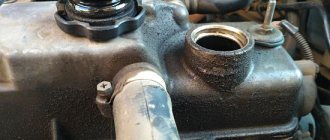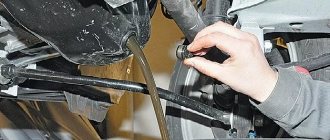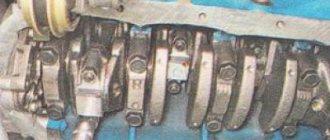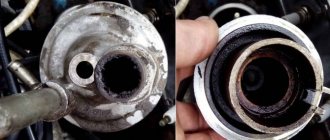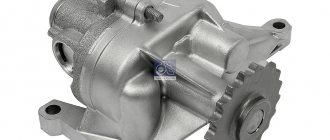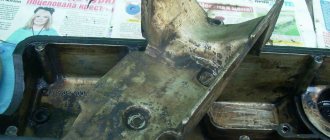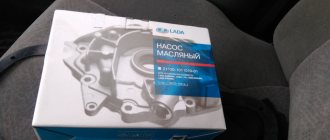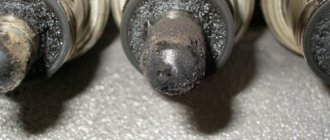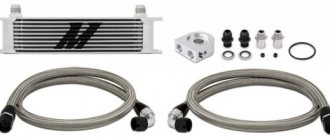The oil pan is a reservoir located under the engine and is designed to collect unused oil that circulates throughout the system. This element resembles a metal bathtub, has a simple structure, and is therefore not susceptible to breakdowns. However, there are times when the container breaks through during off-road travel, or simply rusts. To remove the oil pan, you need to know not only its location, but also its design features.
- Tips and tricks
Design and purpose
The engine oil pan is a metal structure usually made of aluminum, but in older cars it could be made of steel. The shape of the oil pan resembles an elongated rectangular basin; it is attached to the cylinder block from the bottom side through a gasket on studs or bolts. There is a plug on the bottom or side surface designed to drain oil from the engine.
The pan is designed, firstly, to protect the oil receiver, crankshaft, and other parts of the engine crankcase from mechanical damage, dirt and dust. Secondly, it serves as a container for motor oil. It is from this that the oil pump delivers it upward through a filter - to the cylinder head, from where, having lubricated the parts of the gas distribution mechanism and connecting rod-piston group, it flows back.
Replacing the engine oil pan gasket 1.4-1.6(8V) Renault Sandero, Stepway
We replace the oil pan gasket when an oil leak occurs at the junction of the pan with the cylinder block, as well as each time the pan is removed during engine repair.
We carry out the work on an inspection ditch or overpass.
We show the operations on a car with ABS and air conditioning.
We remove the protection of the power unit. Drain the oil from the engine.
Disconnect the exhaust pipe from the exhaust manifold. Remove the rear support of the power unit. We unscrew the three screws securing the front bumper to the subframe (see “Removing the front bumper on a Logan car”).
Unscrew the rear subframe mounting bolts 3–4 turns (see “Removing the subframe”). Having unscrewed the bolts securing the two subframe brackets to the body (see “Removing the lever”) and the bolts of the front fastening of the subframe to the body (see “Removing the subframe”), lower the front part of the subframe on the adjustable stand.
Using a 13mm socket, unscrew the nut of the bolt securing the power steering tube bracket to the cylinder block, holding the bolt from turning with a wrench of the same size.
Using a 13mm socket, unscrew the bolt securing the power steering tube bracket to the air conditioning compressor bracket.
Using a 13mm socket, unscrew the bolt securing the oil pan to the air conditioning compressor bracket.
On the left side of the subframe, use a 10mm wrench to unscrew the nut securing the power steering tube bracket to the subframe.
Remove the power steering tube bracket from the stud.
Using a 13mm socket, unscrew the four bolts securing the oil pan to the gearbox.
Using a 10mm socket, unscrew the 20 bolts securing the oil pan to the cylinder block.
Pulling the subframe down, remove the oil pan and remove it from behind the subframe.
We remove the sealing gasket from the grooves of the oil pan. We clean the mating surfaces of the cylinder block and oil pan from residual sealant and oil.
We wash the inner surface of the oil pan with kerosene.
Installing a new gasket...
...into the grooves of the oil pan. Before installing the oil pan, apply a thin layer of sealant...
...in the area of the front cover of the cylinder block (for clarity, shown with the engine removed)...
...and in the area of the 1st main bearing cover. Install the oil pan and tighten its mounting bolts.
We tighten the oil pan mounting bolts to the prescribed torque (see “Appendices”) in the order shown in the photo. We carry out further assembly in reverse order.
Video on the topic “Replacing the oil pan gasket for a 1.4-1.6 (8V) Renault Logan, Sandero engine”
Oil pan gasket for Renault K7J, K7M, K4M replacement. Oil pump inspection. | Video lecture #2
Volkswagen Passat B3, B4. Replacing oil heat exchanger and oil pan gaskets
https://youtube.com/watch?v=Xc_A9lUZ04M
Let's drain the oil! Renault Logan 1.4 l, remove engine protection. The oil overflows Renault Logan.
Possible faults
Malfunctions of this part do happen, and it is dangerous to ignore them, since loss of oil threatens serious and expensive repairs of the internal combustion engine. They can be easily diagnosed by oil leaks - a characteristic small puddle that remains on the asphalt after an overnight stay and a wet sump. The causes of leaks may be:
- loose oil pan bolt;
- gasket wear;
- loose drain plug;
- cracks in the metal.
Cracks in metal are a much more serious problem than a poorly tightened bolt. They can appear as a result of impacts with large stones, curbs, etc. Even if protection is installed under the crankcase, it can crack due to non-compliance with the bolt tightening torques recommended by the manufacturer. A crack can also occur if the drain plug is overtightened after an oil change or repair. It has a slightly conical shape, is made of a harder metal, and can tear the pan. Such a crack is difficult to see, and some service workers, trying to eliminate the leak near the plug, tighten it even more, which subsequently aggravates the situation.
It is worth noting that a slight “sweating” around the oil drain plug, in the absence of drops or streaks, is normal.
Engine sump: repair
You can often repair or restore the engine oil pan yourself.
When a leak occurs in the area of the gasket between the crater pan and the cylinder block, first of all it is worth checking the tightness of the mounting bolts/nuts. It is necessary to tighten the bolts according to the tightening torques recommended by the manufacturer, otherwise you can strip the threads or cause a crack to appear - then you will have to make more complex and expensive repairs, restoring the tightness of the engine crankcase.
If tightening the bolts does not eliminate the leak, the gasket must be replaced. In this case, you cannot do without removing the pallet. This is not difficult to do from a viewing hole, on an overpass or a lift. We will look at how to remove and install the engine sump yourself below.
The most easily corrected malfunction can be considered a poorly tightened drain plug; they could simply have forgotten to tighten it well after the next maintenance. It is tightened using the appropriate key, by hand, without using additional levers or pipes.
But if you have diagnosed a crack in the oil pan in your car, then the best way to repair it is to completely replace it. However, there are situations when a car of a rare model or a new part is quite expensive, there are several ways to restore its integrity. For example, using glue, dry welding or argon welding.
Removing and installing the engine sump (K4J, K4M engines) Renault Megane II
Place the vehicle on a two post lift.
Disconnect the battery.
Remove the engine oil pan protection. For this:
We unscrew the five bolts securing the engine crankcase protection
We lower the back of the protection and move it back
Removing the crankcase protection
We bite the antennae of the disposable fasteners and remove the mudguard
Draining the oil from the engine
— top engine covers;
Remove the side reinforcements of the subframe (Fig. 5).
Secure the engine cooling radiator using a safety belt to the upper cross member.
Unscrew the nuts and bolts securing the subframe.
Remove the subframe (Fig. 6).
Removing the right front wheel drive
Unscrew the two bottom bolts securing the pallet
Remove the four bolts securing the pan to the clutch housing
Remove the four bolts securing the pan to the front crankshaft cover
Remove the left mounting bolt
Unscrew the seven rear pan mounting bolts
Unscrew the seven bolts of the front mounting of the pallet
Use a screwdriver to pry off the oil pan
We remove the gasket from the grooves of the crankcase.
We clean and degrease the crankcase grooves. Installing a new gasket
We clean the corners of the interface between the oil pan and the cylinder block from sealant residues
Clean the joints of the front crankshaft cover.
Clean the mating surfaces with DECAPJOINT to dissolve any adhering gasket residue.
We apply a special sealant to the corners of the interface between the pan and the cylinder block in the front part of the engine
We also apply sealant to the rear of the engine.
We apply sealant to the joints of the front crankshaft cover with the cylinder block on the oil pump side at the front of the engine.
Also the rear of the engine
If you apply too much sealant, then when tightening the fastening bolts, the excess will be squeezed out.
If sealant gets into working fluids, it can damage some components and assemblies (engine, radiator, etc.).
Rice. 4. Places for applying silicone sealant to the interface of the front cover
Apply two drops of silicone sealant with a diameter of 7 mm to the interface between the front cover and the cylinder block (Fig. 4.) Install the oil damper on the cylinder block.
Rice. 5. Checking the installation of the engine oil pan: 1 - oil control tongues; 2 - pallet grooves
When installing the engine sump, check that the oil cooler tongues fit into the grooves of the sump (Fig. 5)
The planes of the cylinder block and oil pan on the flywheel side are aligned to prevent deformation of the clutch housing.
Install the engine oil pan with a new gasket.
Rice. 6. Procedure for tightening the engine oil pan mounting bolts
Install the oil sump, screw in twenty bolts securing it to the cylinder block without completely tightening it.
Screw in the four bolts securing the oil pan to the clutch housing until they stop, without fully tightening them.
Tighten the bolts securing the oil sump to the cylinder block in the order shown in the figure, first to a torque of 8 Nm, and then finally to a torque of 14 Nm.
Then tighten the four bolts securing the oil pan to the clutch housing to a torque of 27 Nm.
Install all removed parts and assemblies in the reverse order of removal.
How to remove and install the oil pan yourself
This is not a complicated procedure, and most car enthusiasts can do it, although it does require some repair skills and tools. Depending on the brand of the car, nuances are possible. For example, in VAZ cars of the classic family, with a longitudinal engine, you need to lift the engine. Therefore, before you start disassembling it yourself, read the repair manual for your car.
Procedure for removing the oil pan:
- Prepare a clean container - it can be a canister with a wide neck or a cut one. Its volume must correspond to the amount of oil in the engine of your car;
- Drive onto an inspection hole or overpass; it will be more convenient for you if it is deep enough so that you can stand under the car at full height;
- Warm up the engine to a temperature of 50-60 degrees, the engine oil will become thinner and more fluid;
- If the engine compartment protection is installed, remove it; it is usually secured with 3-4 bolts;
- Carefully unscrew the drain plug, placing a previously prepared container under it, be careful - the oil will definitely flow onto your hands and possibly somewhere else;
- Unscrew the oil filler plug. After unscrewing the filler plug, the flow of escaping oil will increase sharply, make sure that it flows into the canister and losses are minimal;
- Wait until all the oil has drained and begin unscrewing the fastening bolts/nuts;
- If all the bolts are unscrewed and the oil pan cannot be removed by hand, this means that the parts have been glued together. You need to tap it with a rubber hammer, carefully pry it with a screwdriver or other flat object, but so as not to damage the joints. Scratches may cause leaks in the future.
Step by step replacement
1. We drive onto the overpass.
2. Unscrew the four bolts securing the crankcase protection.
3. Unscrew and remove the engine splash guard. It is secured with several bolts.
4. Unscrew the drain bolt. Prepare containers for used oil in advance.
Before unscrewing the plugs, the engine needs to be warmed up.
5. Unscrew the nineteen bolts securing the crankcase cover.
6. After unscrewing the fastening bolts, the crankcase cover cannot be easily reached. The beam is in the way.
7. In order to remove the cover, you need to unscrew two engine mounts. The first airbag unscrews from under the hood on the left side. The other one is from under the car, through the hole in the beam.
Next, we raise the car 10-12 centimeters, go to the pit and place a wooden block under the gearbox. We lower the car and it turns out that the body will lower, and the engine and gearbox will stand on a block
Please note that you do not need to lift the car higher than 10 centimeters; if you lift it higher, you can bend the fuel pipes when you lower it
8. Remove the crankcase cover and the old gasket, usually it sticks to the block.
9. Install a new gasket on the base of the pallet, seat the gasket on the sealant.
10. Coat the upper part of the gasket with sealant and install the crankcase cover in place.
11. Secure the crankcase cover with nineteen bolts.
12. Remove the stand from under the gearbox and screw on two engine mounts.
13. Tighten the drain plug in the crankcase cover and fill in new oil to the level.
14. Install and secure the mudguard, as well as the crankcase cover protection.
If you do not understand any point in the work, write your questions in the comments. I will help and advise.
Pad
It is the gasket that ensures a tight connection between engine parts. When purchasing, be sure to match the article number. It is not possible to repair a worn gasket. It is recommended to replace it after each removal of the oil pan during installation. In this case, you need to carefully and very carefully clean the surfaces that will be in contact from the remnants of the old gasket and sealant.
To improve the properties of the gasket, you can use graphite lubricant, a special sealant for the engine crankcase, or any heat-resistant silicone-based sealant.
Graphite lubricant is applied to both sides of the gasket in a thin layer; after assembly, it fills micro-cavities, and hardens under high temperatures.
It is preferable to use a special sealant; it is applied in a thin, uniform layer over the entire contact area, on the pan and on the cylinder block. After assembly, the sealant will dry and, as it were, glue the surfaces, ensuring a tight fit and sealing.
Some craftsmen use sealant instead of a gasket, in which case its layer should be thicker, but it is better to leave this method in case the car is so rare that it is difficult to find the right gasket for it.
Vehicles with a 1.4-/1.6-liter gasoline engine (E7J/K7M)
Attention! To dismantle the oil pan of a 1.4-/1.6-liter gasoline engine (K4J/K4M), it is necessary to remove the power steering hydraulic drive parts. For this reason, the pallet can only be removed in a workshop.
Removal
Attention! Some work on removing the sump is specified in more detail in the chapters “Engine - removal and installation”, as well as “Gearbox - removal and installation”. For this reason, it is also recommended that you familiarize yourself with the provisions of these chapters. Attention! In this case, data is deleted from storage devices, for example, the security code of a radio receiver
Read the recommendations in the chapter “Battery - removal and installation”.
Left side of the car
Attention! Do not allow the drive shafts to tilt at a significant angle, as this may cause damage to the CV boots.
Right side of the car
19.23 Secure the axle shaft with wire to the steering mechanism
19.24 Unscrew nut 1 of the engine and gearbox support
19.33 Use the special tool Mot.1311-06, inserting it into the clamp from the side and pressing
19.36 Attach eye A to the cylinder head to lift the engine. 1.6 liter petrol engine (K7M).
19.0 Drawing of engine lifting eye
19.38 Release the power steering hose from the fastenings on the supporting beam and set it aside from the work site
19.39 Attach two lifting carabiners to the engine eyes
If there is no such lift, then secure the cable in the eyes and lay a fairly thick pipe on which to secure the ends of the cable. Attention! Do not rest the ends of the pipe on the wings.
19.41 Raise the engine with a lift to unload the supports and unscrew the three bolts 6 of the bracket
19.43 Raise the engine from the timing belt side so that the distance between the cylinder block and the support beam A is 26 cm. Attention! When lifting the engine, make sure that the fuse box wiring harness does not get caught or pinched between the transmission (5th gear fork) and the trailing member.
19.44 Unscrew the bolts securing the oil pan and disconnect it, as shown by the arrow in the illustration
Installation
19.47 Apply RHODORSIL 5661 sealant, strip 1, three mm thick, as shown in the illustration, to the sealing surface of the oil pump Attention! The use of solvent is mandatory. Simply rubbing in is not enough. Attention! Wait approximately one hour
This time is necessary for the sealant to harden.
Cold welding
The cheapest way to repair a crack is by cold welding. It is no different in terms of reliability, because it is not brewing, but rather caulking/sealing. Cold welding, as a rule, consists of two components, which are mixed together, applied to the damaged area and allowed to harden. Before doing this, be sure to degrease and thoroughly clean the damaged area. In the case of a small crack, you can try to seal it without removing the pan. When choosing cold welding, pay attention to the temperature at which it retains its properties - it should be at least 200 degrees.
Argon welding
Argon welding is the most effective way to remove damage. This type of welding can be used to weld both aluminum and any other non-ferrous metal alloys. A good welder can easily fix a crack or weld a small hole, and the seam will not affect the functionality in any way. The disadvantage of such repairs is the high price. You can, of course, save money if you remove the part yourself and contact welding specialists directly. But in the case of common brands of budget cars, it will cost less to replace the oil pan with a new one.
You can also use glue for repairs. There are many different types that allow you to seal metal, but epoxy remains wear-resistant, heat-resistant and water-resistant. It is based on resins, substances to accelerate curing, and other fillers. The application of epoxy adhesive is similar to dry welding, it is also two-component and comes in paste or liquid form.
How to protect the oil pan from damage
The oil pan can be damaged as a result of driving on bad roads, hitting a large stone or curb. Therefore, we cannot turn away from the question of its additional protection.
There are several types of engine protection:
Polymer or plastic options cannot guarantee reliable protection, despite their low cost; they should not be installed in bad road conditions.
Aluminum protection is lightweight and corrosion-resistant, but due to its high cost and soft metal, it is also not recommended to use it when driving on bad roads.
Titanium would be an ideal option, in all respects, if not for their high cost. For now, they remain the prerogative of premium cars.
The optimal solution would be engine protection made of steel. It will reliably protect the engine crankcase at its low cost. On many modern cars, the manufacturer provides the possibility of installing engine protection. Therefore, to simplify installation, you need to select it taking into account the make and model of your car. It would be a good idea to seal the protection by installing special inserts so that it does not rattle when moving, or periodically check the tightening of the fastening bolts.
Not only internal combustion engines have a sump. It can also be with an electric motor or gearbox, be it a CVT, manual or automatic. There it performs almost the same functions and in some cases, for example, if it is an SUV for trophy rally, more powerful crankcase protection is required, not only for the engine, but also for other mechanisms.
Replacing the oil pan and its gasket on a VAZ 2101-VAZ 2107
Welcome! Today, many people already know such a thing as an oil pan, but not everyone knows what it really is, when it needs to be changed and how to properly replace it on cars of the “classic” family - we will look at these questions today.
Note! To replace the pan and its gasket, you will need to prepare a few things in advance: First, be sure to stock up on wrenches, or you can use an extension, universal joints and sockets instead!
Summary:
Where is the oil pan and its gasket located? The pan is located at the very bottom of the car engine; unfortunately, in order to fully see the pan it is necessary to remove the crankcase protection, which is done in the figure below:
Note! The blue arrow indicates the gasket that is located between the cylinder block and the crankcase pan!
When do you need to replace the oil pan and its gasket? The pan must be replaced if it is deformed, due to which the engine oil that was located in it begins to flow out of the pan itself.
The pan gasket must be replaced if it is strongly compressed and if it is torn, how do you understand this, you ask? Usually, when the gasket is deformed, engine oil begins to flow through it, but the leak can also be treated by simply tightening the bolts that secure the oil pan, but if tightening the bolts does not produce any results and the leak does not stop, then replace the gasket with a new one.
Question? Which of these two parts are you replacing, the pan or the gasket? (Write your answer in the comments)
How to remove the oil pan on a foreign car
Instructions are provided for the 2003 Mitsubishi Space Star 1.6. In this case, the pan is bolted and located above the muffler. First you need to drain the oil and unscrew the bolts securing the exhaust pipe to the muffler.
Now place a stop under the muffler and remove the rubber bands (usually there are two of them). The stop is necessary to ensure that the lambda probe is not overly stretched and the wires are not damaged.
First you will have to unscrew the gearbox casing, which prevents you from removing the necessary part - you need to remove the casing itself and the plate under it.
Cover that needs to be removed
Next, unscrew the bolts located around the perimeter of the pallet (with a 10-point head), due to which it is held in place.
After this, the tank is still held in place by the sealant. In order for the pan to begin to detach, it is necessary to tap its body with a rubber mallet. If the spare part is not yet worn out, do not hit it too hard, otherwise you may pierce the metal.
Now the part will come off easily. After removal, it is important to check the condition of the oil sump mesh. If there are deposits, the mesh is unscrewed and washed in solvent. It is also important to remove any remaining sealant and then treat the surfaces with a degreaser.
Old and new oil pans
Then everything is put together in reverse order.
In addition to the instructions given, you can also watch a video with step-by-step removal of the pallet:
How to remove the oil pan of a VAZ 2107
Before you begin removing and replacing the pan on a VAZ 2107, you need to understand its purpose, location and damage that entails the need to change the crankcase.
The pan is located at the bottom of the car, and in order to see it and gain access, you will need to remove the protection. Structurally, the device consists of a steel base that resembles a lid. This container contains engine oil, so to ensure tightness, there is a gasket between the crankcase and the cylinder block.
Removing the VAZ 2107 oil pan must be performed when deformations occur, which leads to engine oil leaking out of the engine. There is a lowest point on the cover body where the engine oil drain plug is located. Before removing the oil sump, you must first drain the engine oil.
An oil leak can occur not only when the crankcase is deformed, but also when the integrity of the gasket is damaged. To eliminate the leak, you need to tighten the fastening bolts, and if this does not help solve the problem, then you will need to resort to changing the gasket.
Now, when the need arises to replace the pallet on the seven, we must resort to such manipulations. It is worth noting that the gasket needs to be changed more often, and crankcase defects occur only if there is no protection on the car. Removing the engine oil pan on a VAZ 2107 should be done in the following sequence:
- To begin with, the car should be placed on an inspection hole or overpass. Carrying out work under the bottom without placing the car on a pit or overpass is simply very inconvenient.
- The next step is to begin dismantling the protection, which is secured with 4 bolts.
- After removing the protection, you need to unscrew the oil drain plug. If you plan to change the oil after completing the procedures, it is recommended to warm up the engine to 40-60 degrees before removing the plug. Before unscrewing the plug, you need to place a container into which the oil will drain. You can use an old plastic oil can for this.
- Next, you need to loosen the nuts securing the two engine mounts from under the hood. The nuts need to be loosened, but not completely unscrewed, to avoid the possibility of the engine moving. After loosening the nuts, you need to lift the engine to remove the cover. Without lifting it, it will not be possible to remove the crankcase on the seven.
- There are different ways to raise the engine. The first method is to use a traverse in the form of a wooden block, which is laid parallel to the radiator. A pin, pre-attached to the motor, is passed through the traverse. Screwing the nut onto the stud causes the engine to slowly rise. The second method involves using a winch. The third method is the simplest and most accessible - using a diamond-shaped jack, which is located under the box and, by acting on it, the engine is raised. When the engine rests against the nuts of the mounting brackets, you can continue further manipulations to replace the bottom cover.
- Along the perimeter it is necessary to unscrew all the crankcase mounting bolts, of which there are 19 in total. These bolts are screwed together with the nuts, so when unscrewing them, it is important not to lose them. Some bolts are difficult to reach, so it is recommended to use special hinged wrenches with socket or socket heads.
- After this, you can begin to dismantle the cover, as well as its subsequent replacement. The new crankcase should have a similar design. After the change, the assembly process is performed in the reverse order of dismantling.
When replacing, it is important to consider such points as the plug and gasket. The plug also has a sealing material that wears out, so a new pan must come with a new plug. If it is not there, then it is not recommended to use the old one, and it is better to buy a new one or a seal for it. We will consider the features of replacing the gasket below.
Replacing the seven crankcase gasket
More often it is necessary to replace the oil pan gasket on the seven, since the rubber material tends to wear out. Changing the bottom cover also involves installing a new gasket, since leaving the old seal is strictly contraindicated. It is necessary to change it in order to prevent oil leakage. It is not expensive, so at the first sign of oil leaks, you should change the gasket.
The process of installing a new gasket is similar to the procedure for replacing the crankcase, but some features should be taken into account:
- If the gasket is replaced, the end of the cover where the new seal will be located must be cleaned.
- Before installing the seal, it is recommended to treat it with sealant on both sides. This will increase the tightness of the connection and also eliminate the occurrence of oil leaks.
- When removing the pan, the gasket must be changed in any case.
How to remove the oil pan on a domestic car
Below are step-by-step instructions for a Niva car with a 1.7 injection engine. Before the operation, the machine is placed above the inspection hole. The first step is to warm up the engine so that the oil can be drained while it is hot. Then you should unscrew the spark plugs. Also remove the fasteners from the hood side (2 bolts), due to which the motor is attached to the bridge.
Remove the airbag and protection fastenings.
The engine must be jacked up.
Using a 10mm socket with a ratchet, unscrew the pan. It still rests against the bridge and cannot be removed.
You need to unscrew the two bolts located on the oil pump. After this, the pan will be removed along with the pump.
Replacing the oil pan gasket
Replacing the oil pan gasket in many car models is not a complicated process. You can replace the gasket yourself at home, for example, if you devote a couple of hours to this task on a weekend. This guide shows you the process and the key points you should pay attention to.
And it's better to do it sooner rather than later. A damaged or worn oil pan gasket under your engine can lead to serious oil leaks, overheating of the engine and sometimes catastrophic failure; if the oil level drops significantly without you noticing it, you can trap the engine.
Invest a few hours of your time and follow the systematic procedure described here. This will save your engine from severe damage and your wallet from costly repairs.
This article will cover:
- Preparing for removal
- Removing the oil pan
- Tips and tricks
- Some Important Notes on Gaskets and Seals
- Installing a new gasket
Preparing to remove the oil pan
NOTE. On some models, replacing the oil pan gasket is more difficult. For example, you may need to remove the engine from its mounts using a lift to gain access to it. If you don't know how to access your car's oil pan, look up the manual for your specific make and model online or ask a mechanic at a service station.
The manual shows the location of each bolt and any components you may need to remove for easier access.
1. Raise your car so that it is convenient for you to work on the bottom of the engine
- Drain the oil by unscrewing the drain plug3. Allow the oil to drain completely4. While under the vehicle, look for components and parts, if any, that will prevent you from gaining easy access to the pan with the keys and remove them. The most common items you may have to deal with are cross members, exhaust components, or support brackets.
Removing the oil pan
- When everything is ready, loosen all the bolts located around the pan flange. Sometimes you need to use ratchet handles or ratchet extensions to get better access to some bolts.
- Then finish removing all the bolts and remove the pan from the bottom of the engine block by hand if necessary. If it seems stuck, tap it lightly with a rubber mallet. *However, when the pan does not come loose, make sure that you have removed all mounting bolts and that no other component is holding it in place. * If this doesn't work, use a gasket cutter to cut the seal by pushing the cutter with a rubber mallet between the flange and the engine block in several places around the pan. Do not use a screwdriver to release the pan, otherwise you may damage it or the mating surface of the engine.
- Once you've removed it, check the bottom surface for metal shavings. You may find a few chips, but a large number of them may indicate excessive wear on some engine components. If necessary, contact a repair shop.
- Thoroughly clean the area where the tray is located. You must remove old gasket material and deposits. The gasket scraper speeds up the task without damaging the surface.
- After removing any traces of gasket or silicone, use solvent to clean the mating surfaces and, if necessary, wash the pan with cold detergent. If the grease and silicone are difficult to remove, use carburetor cleaner or engine degreaser and a wire brush to remove this sealant.
- Next, check the pan for damage, such as cracks, and double check the pan flange for bends. You can do this by placing it on a flat surface. The glass surface is perfect for this. * Take a close look at where the flange and glass meet, especially around the bolt holes. * You should not see any spaces. If not, straighten the flange by lightly hitting the curved areas with a hammer.
Crankcase Removal Tools
It is necessary to prepare a set of heads and a ratchet with a cardan. If you don't have a ratchet, you can use a socket wrench. For removal on foreign and domestic cars, a head with a diameter of 10 mm . You will definitely need a flathead screwdriver to pry and remove the pan.
It may be necessary to unscrew the bolts on the oil pump; a wrench with a diameter of 15 mm . And if there is protection, you will also need a 13 mm key . If the part is held on by sealant, a rubber or wooden mallet is needed to remove it. WD-40 lubricant and a torch will help unscrew rusted bolts.
Some Important Notes on Gaskets and Seals
- If you are installing an engine oil pan gasket (as opposed to a rubber seal or compound), you may need special adhesive to hold the gasket in place during installation. If so, apply a light layer of adhesive or high-temp sealant to hold the gasket in place.
- Also, keep in mind that a component at the bottom of the engine may create a connection to another engine component along some portion of the oil pan flange, such as the rear main bearing cap, timing cover, or oil pump. With this configuration, you need to apply sealant where these sections meet to prevent leakage in that area once the gasket is installed.
Some engine pans use rubber seals at each end along with side gaskets. You will need to apply sealant where the rubber gasket meets.
If you are going to use sealant as a gasket, apply it evenly over the contact area to a thickness of 3 millimeters.
Installing the oil pan gasket
Once the pan is in place, begin to tighten the bolts by hand and lightly tighten them, following the criss-cross technique to distribute the force evenly.
NOTE. Some manufacturers recommend applying a small amount of sealant to the bolt threads before installation. Check your service manual if necessary.
Tighten the bolts with a torque wrench in a crisscross pattern to the torque specified in the manual. Do not over-tighten to avoid over-tightening the bolts and damaging the flange or gasket and ultimately causing an oil leak.
- Also, tighten the drain plug to specifications using the same wrench to prevent future oil leaks.
- With the oil pan installed, replace any components that you had to remove to access it. Check that there are no unnecessary parts, as is often the case with master craftsmen.
- Lower the engine from the mounts and tighten the mounts if necessary.
- Lower the vehicle and add the required amount of engine oil to the engine.
- Check for oil leaks after filling, and look under the bottom for the next few days to ensure that you have successfully completed the repair by replacing the oil pan gasket and that you are not dripping or leaking anywhere. Watch the following video for a visual reference. replacing the gasket.
Of course, on some car models it is simply impossible to remove the engine oil pan without the appropriate equipment.
The job of replacing the pan gasket is not an easy task. But in many car models, this task is within the reach of the average owner. However, you must follow the precautions and proper procedures outlined in this manual to complete the job successfully and save money on repairs.
Possible problems when removing the engine sump
Usually it is not possible to remove a part if the bolts are rusty. They need to be unscrewed carefully so that the pins do not break off. It is necessary to preheat the mounting location, and then slowly unscrew the bolt. In domestic cars, the bridge often gets in the way after unscrewing the fasteners. In this case, you should not try to cut off the interfering strips. The problem is solved by removing the oil pump.
Oil pump
It is important to raise the engine to a sufficient height. Otherwise it will be impossible to get to the pallet. The engine is raised until it reaches the nuts securing the mounts. It is convenient to use a diamond-shaped jack for this operation. It needs to be installed under the box; when lifted, the engine will move. Procedure:
- Disconnect the receiving pipe from the manifold, pull out the rods coming from the radiator and heater.
- Disconnect the gas draft loop located on the right, unscrew the casing from the stove.
- Pull out the oil dipstick. Disconnect the tube in which it is placed.
- Remove the clutch box, and then the shield located below the radiator.
- Disconnect the rear support post from the crossbar. Raise the box with a jack, then the handbrake drum will begin to rest against the body. The rear pillar will have to be supported.
- Place a jack under the crankcase and disconnect the cushions. Raise the engine until it stops.
- Place several planks between the motor feet and the cushions. Remove the jack and carefully secure the engine.
- Unscrew the fasteners that hold the crankcase in place. To do this you will need a key with a universal joint. To remove the tray, you need to pull it back.
If there is no jack, a traverse made of timber will do. The beam must be positioned parallel to the radiator. Next, the pin is attached to the engine and threaded through the yoke. Then you need to carefully tighten the nut on the stud. The motor will begin to rise slowly.
It happens that when you try to pry the pan with a screwdriver, it does not budge. In this case, the part gets stuck somewhere inside. First you need to check that all the bolts are unscrewed. In most engines, the cover is held on by 15 bolts, less often by 14. If everything is unscrewed, this means that the oil intake tube is stuck. To solve the problem, you will have to unscrew the tube from the pump.
Tips and tricks
It is possible to dismantle the part only if the preparatory work is carried out correctly. First, the car is placed above the inspection hole; if this is not possible, the body is raised with a jack. After this, it will be possible to get to the crankcase and adjacent parts.
To carry out manipulations, good lighting is required. Without illumination, it is difficult to remove a spare part from a hard-to-reach area. If you have a powerful lamp, it will be possible to inspect the pallet and make sure that there are no dents or holes on it. You will also have to check the condition of the gasket.
If a hole has formed in the housing, repairs can be made using argon welding. Minor cracks are repaired by cold welding, but before doing so, the oil is drained and the surfaces are degreased. Leaks at the junction of the engine block and the sump indicate the need to replace the crankshaft oil seal. Slight sweating around the drain plug is not considered a deviation from the norm.
Welded engine sump
The pan can be accidentally punctured when driving off-road, even with high ground clearance. Many car owners install protection that covers the pan from impacts and complicates access to it. The protection is dismantled in advance; it is usually held on by several bolts and can be unscrewed without any problems.
Crankcase protection
Before dismantling, it is advisable to wipe the tray and surrounding elements with a rag. This makes it more convenient to carry out work, and it is easier to see damage to the body. If oil spills out, the location of the leak is determined visually. To check the integrity, you need to turn on the engine at idle speed. In this mode, oil will quickly begin to flow out through the hole. If after removal you find damage to the gasket, do not throw it away. It is better to take the old seal with you when going to the store. Then it will be easier for the seller to select a similar spare part.
